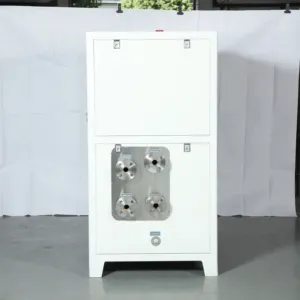An xmtd temperature controller is an advanced instrument engineered to sustain specific temperature levels in industrial or commercial settings. These devices are crucial for operations that demand meticulous temperature control. They operate by gauging the temperature via a sensor and accordingly modulating the heating or cooling mechanisms. The xmtd temperature controller series features models that are adaptable and multifaceted, serving a wide array of temperature management requirements.
Types of XMTD Temperature Controllers
The xmtd temperature controller suite includes diverse models, each tailored with distinct features to accommodate various applications. Some are built for straightforward on/off control, while others incorporate advanced PID control for scenarios where minor temperature fluctuations can have significant effects. Certain models are crafted for high-temperature tasks, and some for low-temperature operations. This range ensures that for any business need, from gradual temperature shifts to swift responses to temperature changes, there is an xmtd controller fit for the purpose.
Structure and Operation of XMTD Temperature Controllers
The construction of an xmtd temperature controller is a testament to engineering prowess, balancing functionality with resilience. Central to the controller is a microprocessor that interprets sensor data and modulates outputs. This core is supported by a circuitry network responsible for power and signal management. User interfaces, from buttons to touchscreens, facilitate straightforward programming and observation, while LED indicators offer immediate status reports. The synergy of these elements guarantees a fluid operation, from initial temperature detection to the ultimate adjustment of heating or cooling.
Materials and Properties in XMTD Temperature Controllers
Materials chosen for xmtd temperature controllers prioritize durability and thermal efficiency. Premium plastics insulate and shield internal parts, whereas metals like aluminum are utilized for their capacity to dissipate heat. The selection of materials strikes a balance between enduring industrial conditions and maintaining precise temperature control. These materials are also selected for their consistent reliability, assuring that the controllers function optimally over prolonged periods.
Business Usages and Applications
XMTD temperature controllers are indispensable across various commercial landscapes. In the food sector, they play a pivotal role in preserving appropriate temperatures for storage and preparation, directly influencing food safety and quality. In pharmaceuticals, they maintain strict thermal conditions for storage and chemical processes, essential for product effectiveness. They are equally vital in electronics manufacturing, where exact temperatures are necessary for soldering components and testing products. These uses underscore the controllers' capacity to bolster product quality, safety, and uniformity, thereby adding value to businesses.
Functions of XMTD Temperature Controllers
The xmtd temperature controller is engineered to execute tasks ranging from the fundamental to the highly intricate. Its core role is to uphold a predetermined temperature in a regulated environment. Beyond this, it can manage ramp/soak profiles, methodically elevating or lowering temperatures as per a set schedule, beneficial in material conditioning and testing. The controllers can also be configured for multiple zones, controlling distinct temperatures in separate areas concurrently.
Features of XMTD Temperature Controllers
Notable attributes of xmtd temperature controllers include their high-definition displays and user-friendly interfaces, simplifying both programming and monitoring. Advanced models boast connectivity features like Ethernet or Wi-Fi, allowing for remote supervision and adjustments. Such connectivity also enables integration with broader automated systems, facilitating centralized management of various processes. These characteristics distinguish xmtd controllers from their rivals by enhancing user experience and system integration.
Benefits of XMTD Temperature Controllers
Employing an xmtd temperature controller offers numerous advantages. They ensure consistent temperature regulation, pivotal in quality-dependent processes. Energy efficiency is another key benefit, as these controllers optimize heating and cooling usage, curtailing waste and operational expenses. The adaptability of xmtd controllers to different sensors and systems means they provide a flexible solution that can adapt to the evolving needs of a business.
How to Use and Maintain XMTD Temperature Controllers
Effective operation of an xmtd temperature controller involves setting precise temperature parameters and vigilantly monitoring the system for discrepancies. Periodic calibration is essential for maintaining accuracy, while sensor cleaning and connection checks help avert common problems. Maintenance should include an examination of wiring and hardware for wear, particularly in demanding industrial settings. Adhering to these practices will prolong the controller's dependability and service life.
Choosing and Installing XMTD Temperature Controllers
Selecting an appropriate xmtd temperature controller necessitates an understanding of the application's specific requirements, such as temperature range, control precision, and sensor type. Installation must adhere to the manufacturer's guidelines, with careful placement of sensors and the controller to prevent interference from external heat sources or electromagnetic disturbances. Proper setup is crucial for the controller's precise and efficient function.
How does an XMTD temperature controller ensure accuracy?
An xmtd temperature controller guarantees precision through its sophisticated PID control algorithm, which continuously fine-tunes the output to minimize temperature discrepancies. High-fidelity sensors deliver exact temperature measurements, and the digital interface allows for meticulous adjustment of settings to align with the application's specific demands.
What customization options are available for XMTD temperature controllers?
Customization possibilities for xmtd temperature controllers encompass OEM, ODM, and OBM support, permitting businesses to personalize the controllers according to their unique needs. Options range from bespoke color selections to the integration of company branding, as well as modifications to control algorithms and sensor types for specialized applications.
Are XMTD temperature controllers suitable for all types of environments?
Although xmtd temperature controllers are crafted for versatility, selecting a model that aligns with the specific conditions of its intended environment is crucial. Considerations such as ambient temperature, humidity, and the presence of corrosive substances are important to ensure the controller's effective and enduring operation.
For enterprises in search of precise temperature control solutions, the assortment of xmtd temperature controllers available on Alibaba.com presents a dependable and customizable option. With comprehensive product details and specifications, Alibaba.com aids industrial purchasers in making informed decisions to improve their temperature management systems.
































 浙公网安备 33010002000092号
浙公网安备 33010002000092号 浙B2-20120091-4
浙B2-20120091-4